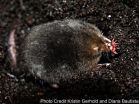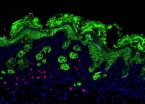(Press-News.org) The most sensitive patch of mammalian skin known to us isn't human but on the star-shaped tip of the star-nosed mole's snout. Researchers studying this organ have found that the star has a higher proportion of touch-sensitive nerve endings than pain receptors, according to a study published January 30 in the open access journal PLOS ONE by Diana Bautista and colleagues from the University of California, Berkeley and Vanderbilt University.
Touch and pain are closely intertwined sensations, but very little is known about how these sensations are detected in our cells. In this study, the authors turned to a unique species for answers: the star-nosed mole. In addition to its distinction as the fastest-eating mammal known, the star-nosed mole also possesses one of the most sensitive tactile organs known in the animal kingdom. The star on its nose has the highest density of nerve endings known in any mammalian skin, with over 100,000 fibers in a patch of skin about 1 cm. in diameter. The authors found these nerve endings significantly enriched in neurons sensitive to light touch, with a lower proportion of neurons that detect and respond to pain.
The novel touch and pain receptors they identified in the star-nosed mole were also detected in sensory receptors in mice and humans, suggesting that these receptors are likely to be more common across other mammals as well. According to the authors, their results highlight how examining diverse and highly specialized species can reveal fundamental aspects of biology common across different animals. Lead author on the study Bautista says, "By studying the star-nosed mole we identified candidate genes that may mediate touch and pain. These genes represent new potential targets for the development of much needed drugs and therapies to treat chronic pain."
INFORMATION:
Citation: Gerhold KA, Pellegrino M, Tsunozaki M, Morita T, Leitch DB, et al. (2013) The Star-Nosed Mole Reveals Clues to the Molecular Basis of Mammalian Touch. PLoS ONE 8(1): e55001. doi:10.1371/journal.pone.0055001
Financial Disclosure: The authors are supported by a U.S. National Institutes of Health Innovator Award DOD007123A, the Pew Scholars Program, and the McKnight Scholars Fund (to DMB) and NSF grant 0844743 (to KCC). The funders had no role in study design, data collection and analysis, decision to publish, or preparation of the manuscript.
Competing Interest Statement: The authors have declared that no competing interests exist.
PLEASE LINK TO THE SCIENTIFIC ARTICLE IN ONLINE VERSIONS OF YOUR REPORT (URL goes live after the embargo ends): http://dx.plos.org/10.1371/journal.pone.0055001
Leading by the nose: Star-nosed mole reveals how mammals perceive touch, pain
Genes expressed in star-nosed mole's star reveal common mammalian touch and pain sensing molecules
2013-01-31
ELSE PRESS RELEASES FROM THIS DATE:
Chimp see, chimp learn: First evidence for chimps improving tool use techniques by watching others
2013-01-31
VIDEO:
This video shows the "dipping " technique performed by chimpanzee Ayumu. Note that he uses his mouth to insert the tube into the bottle. In form, his technique is identical to...
Click here for more information.
Chimps can learn more efficient ways to use a tool by watching what others do, according to research published January 30 in the open access journal PLOS ONE by Shinya Yamamoto and colleagues from Kyoto University and Kent University, UK. Their study ...
Tapeworm eggs discovered in 270 million year old fossil shark feces
2013-01-31
A cluster of tapeworm eggs discovered in 270-million-year-old fossilized shark feces suggests that intestinal parasites in vertebrates are much older than previously known, according to research published January 30 in the open access journal PLOS ONE by Paula Dentzien-Dias and colleagues from the Federal University of Rio Grande, Brazil.
Remains of such parasites in vertebrates from this era are rare- of 500 samples examined, only one revealed the tapeworm eggs. This particular discovery helps establish a timeline for the evolution of present-day parasitic tapeworms ...
Pact invests US $109 million to secure critical genetic material, maintain global food production
2013-01-31
Contact: Michelle Geis
mgeis@burnesscommunications.com
301-280-5712
Contact: Susan Tonassi
301-280-5711
stonassi@burnesscommunications.com
Pact invests US $109 million to secure critical genetic material, maintain global food production
CGIAR consortium partners with global crop diversity trust to revitalize genebanks housing scores of crops considered essential to food security
BONN, GERMANY (31 JANUARY 2013)—Concerned that inconsistent funding eventually could weaken a global network of seed banks at a time when farmers face unprecedented challenges, two ...
Forsyth scientists gain new understanding of latent tuberculosis
2013-01-31
Scientists at the Forsyth have gained new insight on how Tuberculosis (TB) remains a global epidemic. Although drugs have been available to fight TB for 50 years, the disease still infects nearly 2.2 billion people worldwide and causes 1.7 million annual deaths. This is largely attributed to the bacteria's ability to stay dormant in the human body and later resurface as active disease. The Forsyth team, and its collaborators from Stanford University, has recently discovered that Mycobacterium tuberculosis, the bacteria that causes TB, can lay dormant and thrive within ...
Itching for new help for eczema: Recently identified immune cells possible therapeutic target
2013-01-31
PHILADELPHIA - The increasing incidence of allergic skin diseases, and the accompanying economic burden and heightened risk of developing other allergic conditions, have spurred researchers to look for better ways to control these immune system-based disorders.
Atopic dermatitis, more commonly called eczema, now affects 10 to 20 percent of children in the United States and direct health-care costs exceed $3 billion, according to the National Institute of Arthritis and Musculoskeletal and Skin Diseases. What's more, up to 50 percent of children with atopic dermatitis ...
Scientists may have received millions in duplicate funding
2013-01-31
Big Data computation at the Virginia Bioinformatics Institute at Virginia Tech reveals that over the past two decades funding agencies may have awarded millions and possibly billions of dollars to scientists who submitted the same grant request multiple times — and accepted duplicate funding.
An analysis led by Harold R. Garner, a professor at Virginia Tech, not only indicates that millions in funding may have been granted and used inappropriately, it points to techniques to uncover existing instances of duplicate funding and ways to prevent it in the future. The analysis ...
Setting the stage for a new paradigm in treatment of heart failure
2013-01-31
CHAPEL HILL, N.C. – Despite a substantial increase in the number of people suffering the debilitating and often deadly effects of heart failure, treatments for the condition have not advanced significantly for at least 10 years. An analysis by researchers at the University of North Carolina School of Medicine shows new breakthroughs could be closer than we thought.
The analysis points to striking similarities between heart cells in patients with heart failure and brain cells in patients with Alzheimer's disease, raising the possibility that some treatment approaches being ...
Current evidence does not support selenium for preventing heart disease in well-nourished adults
2013-01-31
A systematic review published today in The Cochrane Library finds that in well-nourished adults current evidence does not support selenium for preventing heart disease. The review suggests that taking selenium supplements does not reduce a person's risk of developing heart disease, although most evidence is currently limited to healthy American adults.
Diet is a key factor influencing heart disease risk. Selenium is one dietary element that could potentially play a role in preventing heart disease by protecting against oxidative stress and inflammation. It is a common ...
Brain activity study lends insight into schizophrenia
2013-01-31
Magnetic fields produced by the naturally occurring electrical currents in the brain could potentially be used as an objective test for schizophrenia and help to better understand the disease, according to new research published today.
A team of researchers from Plymouth and Spain have used the non-invasive magnetoencephalogram (MEG) technique to find two spectral features that are significantly different in schizophrenia patients compared to healthy control subjects.
Furthermore, they found that there were four spectral features in the brain signals of schizophrenia ...
Dementia: Cerebrolysin shows promise
2013-01-31
Dementia patients may benefit from a promising new treatment called Cerebrolysin, according to the results of a systematic review published in The Cochrane Library. The authors brought together the most up-to-date evidence on Cerebrolysin as a treatment for vascular dementia.
Vascular dementia is a common form of dementia caused by damage to the network of blood vessels supplying the brain. Some of the symptoms are similar to those associated with Alzheimer's disease and stroke but in particular those with vascular dementia often experience difficulty thinking quickly, ...
LAST 30 PRESS RELEASES:
Concurrent frailty + depression likely boost dementia risk in older people
Living in substandard housing linked to kids’ missed schooling and poor grades
Little awareness of medical + psychological complexities of steroid cream withdrawal
Eight in 10 trusts caring for emergency department patients in corridors, finds BMJ investigation
NASA’s Webb telescope finds bizarre atmosphere on a lemon-shaped exoplanet
The gut bacteria that put the brakes on weight gain in mice
Exploring how patients feel about AI transcription
Category ‘6’ tropical cyclone hot spots are growing
Video: Drivers struggle to multitask when using dashboard touch screens, study finds
SLU research shows surge in alcohol-related liver disease driving ‘deaths of despair’
Rising heat reshapes how microbes break down microplastics, new review finds
Roots reveal a hidden carbon pathway in maize plants
Membrane magic: FAMU-FSU researchers repurpose fuel cells membranes for new applications
UN Member States pledge to increase access to diagnosis and inhaled medicines for the 480 million people living with COPD
Combination therapy shows potential to treat pediatric brain cancer ATRT
Study links seabird nesting to shark turf wars in Hawai‘i
Legal sports betting linked to sharp increases in violent crime, study finds
Breakthrough AI from NYUAD speeds up discovery of life-supporting microbes
New Eva Mayr-Stihl Foundation funding initiative boosts research at University of Freiburg on adaptation of forests to global change
The perfect plastic? Plant-based, fully saltwater degradable, zero microplastics
Bias in data may be blocking AI’s potential to combat antibiotic resistance
Article-level metrics would provide more recognition to most researchers than journal-level metrics
Satiety’s little helper: Protein that supports appetite regulating protein identified
UF dives deep into predicting storm damage with computer models
A stormy ocean voyage yields insights on the global carbon cycle
Scientists identify first non-coding gene that controls cell size
Demonstration of altermagnetism in RuO₂ thin films -- A new magnetic material for the AI era
Penn researchers awarded $25M to conduct trial using smartphones to fight heart disease
PCORI awards funding for new patient-centered healthcare research
Exploring the origins of the universe: 145 low-noise amplifiers complete ALMA telescopes
[Press-News.org] Leading by the nose: Star-nosed mole reveals how mammals perceive touch, painGenes expressed in star-nosed mole's star reveal common mammalian touch and pain sensing molecules



